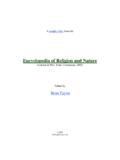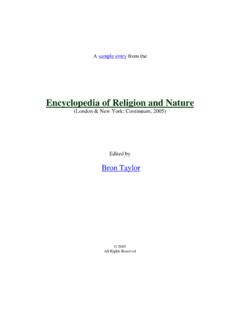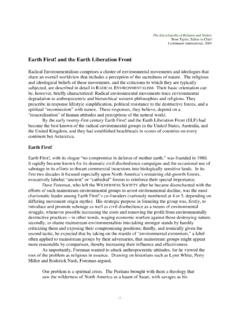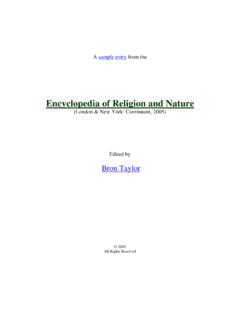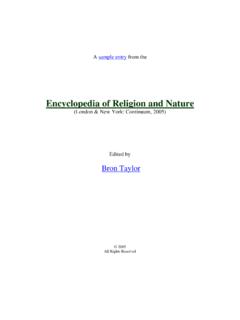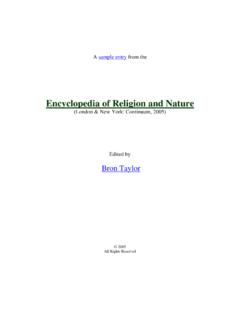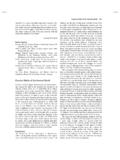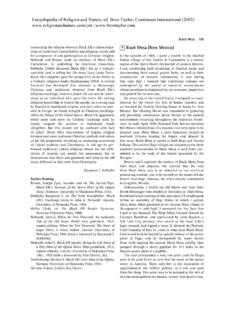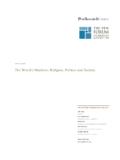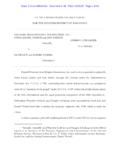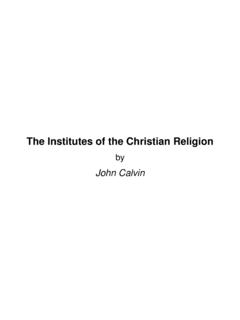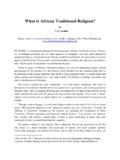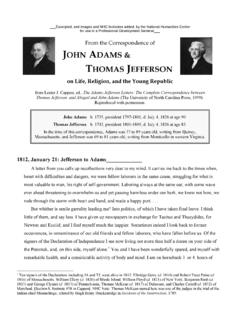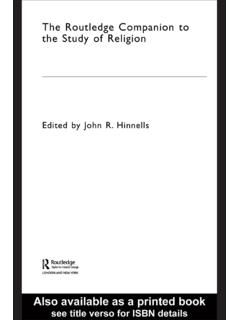Transcription of Encyclopedia of Religion and Nature
1 A sample entry from the Encyclopedia of Religion and Nature (London & New York: Continuum, 2005). Edited by Bron Taylor 2005. All Rights Reserved Lakota 983. Ovid. The Metamorphoses. Mary M. Innes, tr. Middlesex, special relationship. The decline of buffalo numbers, as England: Penguin Books, 1955 (1970). well as of other game and vegetal resources, was due to Rigoglioso, Marguerite. Mysticism, Mother Worship, and overhunting, deliberate destruction of food resources to Misogyny in the Navel of Sicily: A Spiritual History of restrict the movement of the Lakota and other Plains Enna, Lake Pergusa, Demeter, and Persephone. Ann groups, and disruption of habitat and loss of grazing land Arbor, MI: Bell & Howard Information and Learning, through European immigration and then settlement. 2001. This decline was apparent by the 1840s, and the buffalo Sinicropi, Enrico.
2 Enna nella stora nell'arte e nella vita. all but disappeared from the Western plains by the time of Palermo: Antonio Renna, 1958. the last hunt in 1883. At the same time the United States See also: Gimbutas, Marija; Greco-Roman World; Ovid's began restricting the Lakota to reservations in violation Metamorphoses; Roman Natural Religion ; Sacred Space/ of earlier treaty agreements. Lakota lands were further Place. diminished through government legislation (the Allotment Act), which assigned speci c amounts of land to indi- vidual Lakota and sold off surplus lands. This policy Lakota continued up until the 1930s. The Lakota have no word for Religion . Belief in and The Lakota, (known historically as the Teton, Sioux and interaction with the sacred are not restricted to certain Dakota) are composed of seven tribes: Oglala (They Scatter times, places, or activities, in contrast to Western belief Their Own), Sicangu (Burned Thighs, also know as Brule), systems in which sacred and profane are important binary Oohenunpa (Two Kettles), Itazipco (Sans Acrs, Without oppositions.)
3 The Lakota held and continue to hold that Bows), Hunkpapa (End of the Camp Circle), Sihasapa all is sacred (wakan), although certain objects, activities, (Blackfeet), and Mnicowojou (Planters by the Water). As and even persons are imbued with more of this sacrality they moved west out of Minnesota, they became nomadic than others. This sacrality can also be sought and obtained hunter-gatherers whose resource base included a large by such means as prayer, fasting, self-sacri ce, and number of game animals, particularly the buffalo, but also generosity. Thus, all of Nature is sacred, while certain elk, deer, and other mammals, as well as seeds, fruits, places, events, and relationships may be more sacred than roots, and tubers. They also traded or raided for agricul- others. Thus many contemporary Americans see the world tural products such as corn and squash with the native in terms of sacred times and non-sacred times and attempt peoples to the east.
4 The appropriation of the horse after to draw a careful distinction between Church and state European incursion to the Americas extended their geo- while Lakota do not make these divisions. To express these graphical range and increased their food supply. Ri es different worldviews, some Lakota say that Whites have increased successful hunting of fur-bearing mammals and Religion while Lakota have spirituality.. allowed the Lakota to engage in the fur trade as early as The Lakota believed and continue to believe that main- the second half of the eighteenth century. This trade taining moral bounds, expressed as doing things in a expanded as late as the 1850s. good way is key to success in hunting and in all of life's Anthropology and Lakota oral tradition provide a endeavors. The Lakota did not and do not live in a world variety of explanations for the origins of the Lakota and of total ecological harmony or mystical participation with their geographical location on the Plains.
5 According to all beings: rather they seek balance in the world through Lakota oral history, the Lakota emerged from under the reciprocity. At the same time the Lakota remain highly Earth in the Black Hills, the spiritual center of their uni- pragmatic in determining causes for disasters in the world, verse, and were the rst people in existence. The Black such as the near-extinction of the buffalo, and seek Hills, along with other locations, are therefore part of a remedies that will serve the needs of future generations. sacred geography that encodes Lakota oral and written According to Lakota oral history, the Lakota were history and to which important pilgrimages continue to be granted their spiritual and social organization from a made. sacred person, the White Buffalo Calf Woman, who gave According to archeology, linguistics and ethnohistory, the people, at a time of starvation, the sacred pipe along the Lakota, not yet differentiated into their current with a promise to teach them the rituals and morality political con guration, came to the western Plains from required for living as a united group.
6 This pipe links the what is now southern Wisconsin, southeastern Minnesota, Lakota to the buffalo as generous relatives who would give and northeastern Iowa. They migrated to the Plains by the their very lives to sustain their kin. The Lakota's buffalo latter 1700s. The western migration of the Lakota was a relatives would express familial generosity by providing response to European immigration that pushed tribes food and many other useful products. such as the Anishnabe (Ojibwa) further west as well as an Religious revelation through personal quest, dreams, attraction to abundant game, especially the buffalo, a key and visions remains an important part of this highly spiritual and nutritional resource with which they have a charismatic belief system. Thus Lakota spirituality is not a 984 Lakota static set of dogma and precise rituals, locked in a past oral resources, and, with the coming of Whites, new that can only be duplicated.
7 Rather, it is a dynamic belief catastrophic diseases, diminution of their land base, system, respectful of and linked to past practices reacquisition of resources such as water, timber and land, but highly adaptive in addressing contemporary needs. preservation of spiritual resources, and care for a rapidly Spiritual leadership comes through the spiritual and life increasing population. experiences of individuals who take up these roles for the The Lakota recognize that their beliefs and rituals have good of the community. Their authority is af rmed by diffused to other native and non-native groups. In con- their success in prayer, their good lives, and the allegiance temporary discussions of their own culture, Lakota move of others who also seek the wakan (holy) through their between the poles of universalism and particularism in leadership.
8 While the belief system is uni ed by a common dealing with the spread of their beliefs. For example, the set of rituals and key symbols, there is freedom for indi- four colors used in rituals to symbolize and mark out the vidual variation and innovation, always monitored by four directions of the universe are also interpreted today to elder spiritual leaders and general participants. represent the four races of humanity: red, white, yellow The key metaphor for Lakota culture is kinship or and black. At the same time there is lively debate over how relatedness. Thus the term to pray is also the term used far non-Lakota and especially non-Indians should enter to address someone as a relative. The Lakota see their into the ritual life of the Lakota. Universalists argue that relationship to their relatives, whether through blood, because the four colors are included in a sun dance or a marriage, or adoption as a sacred responsibility.
9 This sweatlodge or a yuwipi all people must be welcome;. kinship extends not just to humans but, most importantly, others hold that these ways were given particularly to to the entire universe. Ritually, the Lakota re-create the the Lakota and can only properly be used by the Lakota. sacred cosmos that is coterminous with the natural and Particularists point to numerous examples of exploitation supernatural world through marking out and praying of Lakota rituals for money or individual prestige. toward the cardinal directions, the heavens and grand- Between the poles of exclusion and inclusion, particularist mother Earth (unci maka). Colored ags and the arrange- and universalist, there is a gradient: many Lakota welcome ment of participants in a circle make physical this cosmic non-Indians provided they are respectful, do not try to map.
10 Rituals call on wakan entities to help the partici- assume leadership roles or try to control the ceremonies, pants in various tasks and trials. Voluntary suffering and and do not begin conducting the ceremonies on their own. esh offerings are offered in exchange for this divine Some Lakota will give ceremonial leadership for speci c patronage. Lakota stress that spirituality should not be rituals to non-Indians: others maintain a total prohibition used to enhance one's own prestige. Rather, spirituality of non-Indian involvement, excluding even the obser- and ritual should bene t relatives, and indeed the entire vation of spiritual events. Essential for participating in universe. One frequently hears prayers for the protection Lakota ceremonies are the relationships one has developed of creation, the cessation of pollution, the survival of with the praying community.
